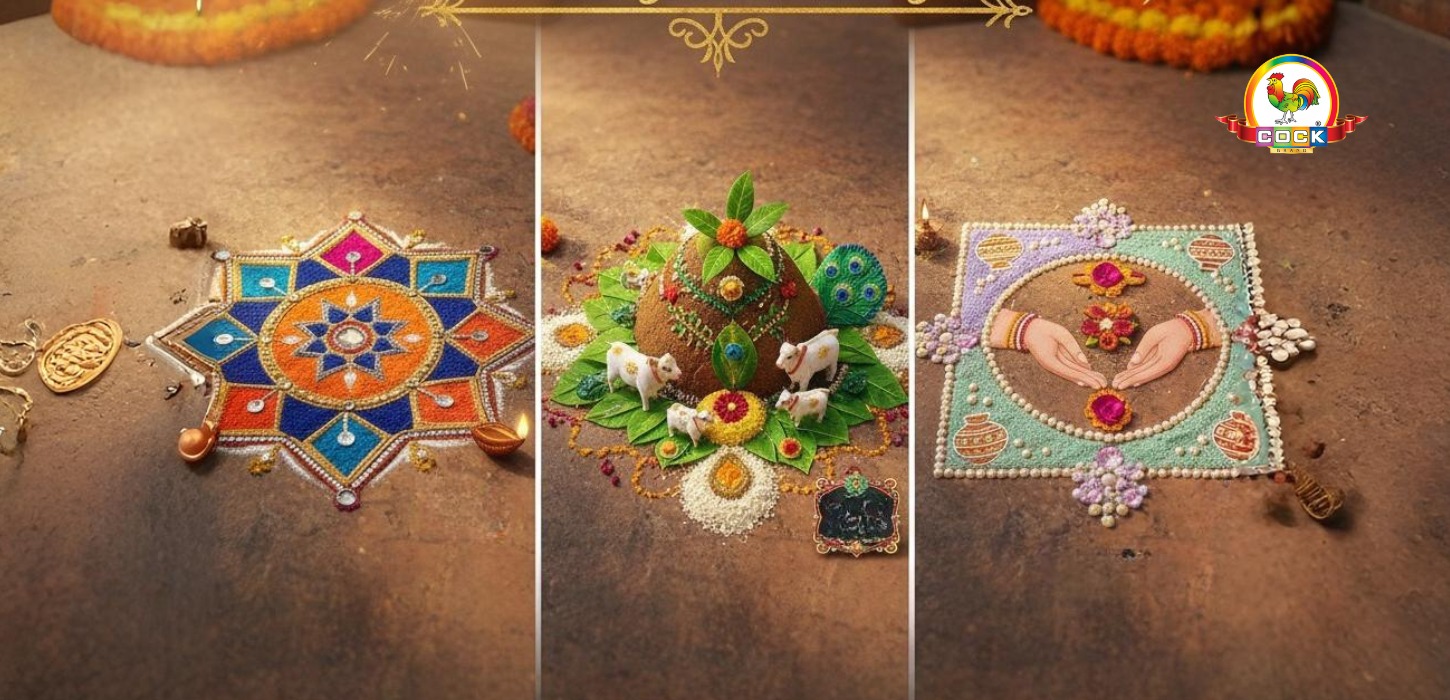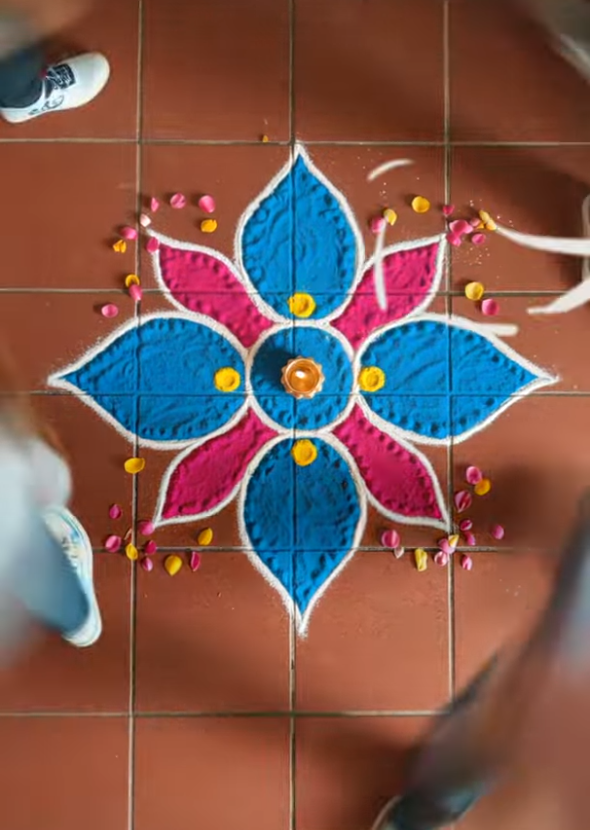
Diwali, the festival of lights, is one of India’s most celebrated and spiritually significant festivals. It symbolizes the victory of light over darkness and good over evil. Apart from lights and sweets, beautifully crafted Rangoli designs play a vital role in adorning homes and welcoming Goddess Lakshmi.
Here are the key details:
Amavasya Tithi: Begins October 20 at 03:44 PM and ends October 21 at 05:54 PM.
Lakshmi Puja Muhurat: October 20, 2025 — 07:08 PM to 08:18 PM.
This is the most auspicious time to perform Lakshmi Puja, light diyas, and decorate your home with vibrant Rangoli designs made from eco-friendly, organic colours.
The use of organic powders and floral Rangolis has become a popular trend for Diwali 2025, aligning beauty with sustainability.
The day after Diwali is celebrated as Govardhan Puja, also known as Annakut. On this day, devotees worship Lord Krishna and express gratitude towards nature for nourishment and protection. Rangolis during Govardhan Puja often depict nature, cow motifs, or Krishna symbols.
Pratah Kala Muhurat: 06:26 AM – 08:42 AM
Sayan Kala Muhurat: 03:29 PM – 05:44 PM
During this time, devotees create Rangoli designs around temple spaces, home entrances, and areas where Govardhan offerings are placed. Bright shades like yellow, green, and orange are ideal for these Rangolis, as they reflect the vibrancy of nature.
For an eco-conscious celebration, use Organic holi colours or natural powders made from turmeric, sandalwood, and rice flour. They not only enhance colour depth but also ensure that the environment remains unharmed.
Bhai Dooj marks the end of the Diwali festivities. This beautiful celebration honors the bond between brothers and sisters. Much like Raksha Bandhan, the day revolves around rituals, prayers, and love shared between siblings.
Dwitiya Tithi: Begins October 22 at 11:18 PM, ends October 23 at 09:30 PM.
Sisters often decorate their homes and puja spaces with creative Rangoli designs that include small diyas, floral motifs, or symbols of prosperity. Using soft pastel shades and vibrant Rangoli colours can make your design elegant and meaningful for this special day.
The festival season in 2025 is all about minimalist yet artistic Rangoli patterns that combine tradition with modern creativity. Below are some trending Rangoli ideas for Diwali, Govardhan Puja, and Bhai Dooj that will help you make your festive décor stand out.
Mandala-style Rangolis made with flower petals and Organic holi colours create stunning symmetry. Combine marigold, rose, and jasmine petals with shades of yellow, red, and green to create a floral masterpiece.
Peacock Rangolis are timeless. This year, the trend emphasizes gradient shading — blending multiple hues for depth. Use natural powders like Murga gulal or eco-friendly gulal for soft, vivid finishes.
Geometric Rangolis give a modern touch to traditional décor. Use stencils or chalk outlines to create clean edges and fill them with bright Rangoli colours for a neat, sophisticated look.
If you’re short on time, ready-made Rangoli kits or stick-on designs are a perfect solution. They come in vibrant shades and are easy to place at entrances, balconies, or tabletops.
Floating Rangolis, created in large bowls with flowers and floating candles, are trending for 2025. Add organic powder at the base of the water to give a colourful glow effect.

As design preferences evolve each year, Rangoli trends in 2025 reflect sustainability, artistry, and ease of execution. Below are practical tips and key trends to help your Rangoli art stay vibrant and long-lasting:
Using Organic holi colours ensures that your Rangoli remains safe for the environment and skin-friendly for kids. Powders made from natural ingredients like flowers, turmeric, and rice are biodegradable and long-lasting.
A subtle shimmer effect using metallic dust or natural mica adds glamour without overpowering the design. These work beautifully under diya light during Diwali evenings.
Combine powder Rangoli with real petals, coloured sand, or pulses for a mixed-media design. This hybrid approach gives your Rangoli a textured appearance and enhances its durability.
Using stencils or pre-drawn outlines helps maintain balance in your Rangoli designs. Borders in white or gold make colours stand out more vividly.
To prevent smudging or fading, apply a thin layer of chalk powder or flour as a base. Avoid areas with direct foot traffic or shield your Rangoli using decorative lamps.
Each occasion in the Diwali week has its symbolism —
Diwali: Diyas, lotus, and Lakshmi motifs.
Govardhan Puja: Krishna symbols, cows, and natural elements.
Bhai Dooj: Dotted or circular designs that symbolize unity and bonding.
Check out our channel:
In 2025, the emphasis is shifting toward sustainable celebration. Chemical-based powders fade quickly, create dust, and harm both the skin and the environment. On the other hand, Organic holi colours and natural Rangoli colours offer rich pigmentation, smooth texture, and vibrant longevity.
They’re perfect for artistic DIY projects and safe for children who love to participate in creating festive decorations. By making this small switch, you contribute to an eco-friendly festival that is both beautiful and meaningful.
If you want your Rangoli to stay bright and fresh longer, follow these steps:
Always prepare the surface by wiping it clean and dry.
Apply a base layer using rice flour or chalk powder.
Use fine-grain Rangoli colours for smooth and neat designs.
Avoid direct airflow or areas where people walk frequently.
Seal the edges using clear spray fixative or rangoli spray mist (optional).
With these small care tips, your Rangoli will remain intact for three to four days, making your entire festive week vibrant.
Rangoli is more than an art form; it’s a symbol of positive energy. Every pattern drawn brings with it warmth, joy, and an open invitation for prosperity. As families gather to create these designs, it becomes a shared moment of creativity and togetherness.
Whether it’s Diwali, Govardhan Puja, or Bhai Dooj, the joy of creating Rangoli remains the same — a beautiful expression of love, devotion, and festive spirit.
As we approach Diwali 2025, it’s time to combine creativity with sustainability. Using eco-friendly Rangoli colours and embracing the latest trends ensures that your home radiates joy, positivity, and environmental responsibility.
From intricate Rangoli designs on Diwali night to natural patterns during Govardhan Puja and Bhai Dooj, every celebration can shine brighter with organic artistry.
Choose vibrant, non-toxic shades that stay beautiful throughout the festival week and reflect the true essence of Indian tradition — colourful, conscious, and full of life.
Make your 2025 Diwali décor stand out with long-lasting, radiant Rangolis with Cock colours — a true blend of art, culture, and sustainability.
